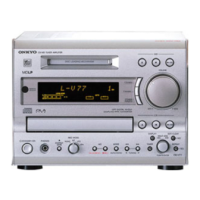38
Recording from a connected source to an MD
You can record the sound from connected equipment (see page 8) onto an MD.
Digital or analog recording is possible depending on the connected source.
1 Insert an MD.
Use a recordable MD with the record-
protected window closed.
2 Press TAPE/LINE repeatedly until
the wished source appears in
the display.
The source name appears in the
following way:
TAPE→LINE-1→LINE-2→DIGITAL
↑
Notes
• If you changed the source name (see
page 45), the new source name appears.
• If the DIGITAL indicator flashes in the
display when you have selected DIGITAL,
no digital equipment is connected or the
connected digital component is not turned
on.
3 Press REC to set the MD to
recording pause.
Note
If “D.In Unlock appears or the DIGITAL
indicator flashes in the display when you
have selected DIGITAL, no digital
equipment is connected or the connected
digital component is not turned on.
If the MD does not set recording
pause
See “When dubbing does not start” on
page 22.
4 Start playing the selected
source.
SLEEP SOURCE C D TIMER M D M D
CH
C D
C D
ONCE
W.DAY
W.END
REC
L
R
S.BASS
-
40
-
20
-
10 0 OVER
-
6
-
2
MUTING DIGITAL CHAIN
REPEAT
DISC TRACK ELAPSED REMAIN TITLE
RDS MONO AUTO STEREO TUNED
1 TR MEMORY
RANDOM
LEVEL - SYNC
-
M D
DUB TOC
5 Press MD to start
recording.
To change the LevelSync function
setting
See page 25.
To mark a track number while
recording
Press REC while recording. Keep a
sufficient interval (more than four seconds)
to mark the next track number. If it is too
short, the track number may not be
marked.
To pause recording
Press MD .
To restart recording, press the same
button.
To stop recording
Press MD .
Recording automatically stops when the
end of the MD is reached.
To adjust the recording levels
See page 25.
To check the completed recording
See page 22.
6 Press MD when you have
finished recording.
See “When the TOC indicator lights or
flashes” on page 23.
About digital recording
This unit is equipped with a digital input signal
sampling frequency rate converter which converts the
other type of sampling frequency to 44.1 kHz before
recording. This enables the unit, other than the CD
player which has the same sampling frequency, to
digitally record the source with different sampling
frequencies, such as a DAT or satellite broadcast
whose sampling frequency is 32 or 48 kHz.
SLEEP SOURCE C D TIMER M D M D
CH
C D
C D
ONCE
W.DAY
W.END
REC
L
R
S.BASS
-
40
-
20
-
10 0 OVER
-
6
-
2
MUTING DIGITAL CHAIN
REPEAT
DISC TRACK ELAPSED REMAIN TITLE
RDS MONO AUTO STEREO TUNED
1 TR MEMORY
RANDOM
LEVEL - SYNC
-
M D
DUB TOC
2
5
6
1
3
TAPE / LINE
RECBBING
M D
Das private Onkyo Archiv © von Dirk Gardi
Der Online-Treff zum Thema Onkyo!
www.gardi.de
Das private Onkyo Archiv © von Dirk Gardi
Der Online-Treff zum Thema Onkyo!
www.gardi.de
Das private Onkyo Archiv © von Dirk Gardi
Der Online-Treff zum Thema Onkyo!
www.gardi.de

